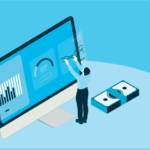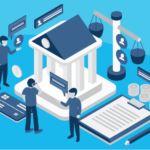Top Digital Lending Software Features – Digital lending has revolutionized the business processes of financial institutions, empowering banks, credit unions, fintechs, and non-bank lenders to streamline the entire loan lifecycle from the time a customer applies for their loan, through to disbursement and repayment. However, not all digital lending software is created equal. The success of digital lending really hinges on finding a solution with all the best digital lending software features that meets your business needs, provides a great user experience, enables compliance, and scales easily.
In this blog, we will assess the top features that any digital lending platform should have on offer, why these features are so relevant for operational success in today’s competitive lending environment. 
End-to-End Loan Origination Automation
One of the most fundamental features in any digital lending software is the loan origination automation capability. A fully automated LOS completely transforms the way you work by reducing manual processes, which also means you will reduce the underwriting timeline. When you automate the customer journey from initial customer information collection, identity validation, and credibility check, you can eliminate human error and increase efficiency. At a minimum, you should have the following capabilities –
- Online loan applications
- Document upload & verification
- Automated credit checks & scoring
- Eligibility assessment workflows
All of this creates a convenient and efficient experience for customers applying for loans (and getting quicker decisions), and reduces operational costs for the lender.
Strong Risk Assessment and Decisioning Engine
A strong AI-enabled decisioning engine is necessary for accurate, real-time credit decisioning. The modern solution will effectively stitch together with a variety of external data sources, including credit bureaus, bank statement analyzers, and even alternative credit scoring and assessments. This improves lenders’ ability to mitigate the risk of default by assessing real financial health across multiple data points. Look for platforms that can provide –
- Custom rule building
- Real-time decisioning
- Fraud and KYC/AML checks
- Machine-learning-based risk models
With credit risk assessment powered by extensive sources of data, lenders can approve more loans promptly for managing their risk, delivering a competitive advantage.
Seamless Integration Support for 3rd Party Services
Leading digital lending platforms help lenders easily connect to 3rd party services. Effective decision-making could involve pulling credit reports, verifying income, digital signatures, and sending disbursement instructions back to core banking systems. Access to 3rd party services is critical to ensure a seamless lending process. Common services for connection include –
- Core banking platforms
- Credit bureaus
- e-KYC and AML services
- Payment processing and accounting systems
- Cloud storage and CRM
Access to flexible API and webhook capabilities is a requirement for connecting to these services; therefore, the software solution must maintain an open architecture.
Mobile-First and Omnichannel User Experience
Modern borrowers generally expect to apply for and receive a loan via mobile or mobile-equivalent device. This could take the form of a mobile app, mobile-enabled web browser, or web-enabled portable computing application. Ultimately, the channel through which the borrower engages is secondary to the lender’s strategy for delivering an experience. A well-known automobile manufacturer, a few years ago, converted a community bank’s lending strategy to a mobile-style application approach with the bank’s new mobile app, complete with digital signature.
In this case, the brand lent itself, becoming a supplier to a mobile application for the bigger brand. With a mobile-first and omnichannel approach, customers have a seamless experience across smartphones, tablets, and desktops. The benefits of this approach are improved customer engagement and improved application conversions. Key features include –
- Responsive UI/UX across devices
- Native apps for borrowers
- Push Notifications for loan updates
- Self-service dashboards and loan tracking
Mobile optimization is also far more important for serving millennials and Gen Z borrowers, who prefer digital-first experiences.
Regulatory Compliance and Data Security
Financial institutions are heavily regulated concerning data protection, anti-money laundering (AML), and disclosures required for consumer lending. The best digital lending software will come with built-in compliance and security features. The following key compliance and security features should be included –
- GDPR, CCPA, and PCI-DSS compliant
- Real-time audit trails
- Role-based access control
- End-to-end encryption and secure cloud hosting
- Electronic consent and compliance disclosures
These features mitigate penalties, breaches and foster trust in your borrowers.
Loan Servicing and Collection Tools
We have established that loan origination is only half the battle. The top digital lending platforms should also have post-disbursement management options available, such as servicing, repayment tracking, and collection capabilities. This promotes consistency and lessens the need to hop between software systems. Required servicing features include –
- Payment scheduling and reminders
- Auto-debit setup
- Delinquency tracking
- Automated collections workflows, reporting, and analytics
These features aid lenders in maintaining healthy portfolios and improve recovery rates on non-performing loans.
Customizable Workflows and UI
Every lender has different operational needs and customer segments. The most effective platforms provide customization options to customize workflows, interfaces, and loan products according to your requirements. Advantages of customization include –
- Branded portals for various customer types.
- Workflow automation for different loan products.
- Localization for language, currency, and regional regulations.
No-code or low-code platforms can be specifically helpful for non-technical teams managing loan operations.
Advanced Analytics and Reporting
To make knowledgeable decisions, lenders need real-time insights into their portfolios. Advanced analytics tools allow data-driven strategies, helping lenders optimize pricing, reduce risk, and predict demand. Key analytics features include –
- Loan performance dashboards
- Risk segment tracking
- Cohort analysis
- KPI tracking
- Custom report generation
These tools empower leadership teams with actionable intelligence to improve performance and compliance.
Scalability and Cloud Infrastructure
As your business grows, your lending platform should scale with you. Cloud-native digital lending software provides the elasticity and uptime required for peak demand without performance degradation. Scalable features to think about –
- Multi-tenancy support
- Auto-scaling infrastructure
- Global housing options
- API load balancing
- Disaster recovery and backup protocols
A strong cloud environment ensures seamless operations during traffic surges, market expansions, or seasonal lending cycles.
Conclusion
Selecting a digital lending platform is one of the most essential technology decisions a lender can make. The top digital lending software features go far beyond basic loan application tools. From advanced decision engines and compliance frameworks to user experience and scalability, these features define how effectively a lender can compete in today’s progressive market.
Whether you are a traditional financial institution going through transformation or a fintech startup scaling your lending services, focusing on these important features will set the foundation for long-term success.
FAQs
What is digital lending software?
Digital lending software is a platform that automates the loan lifecycle, including application, underwriting, disbursement, servicing, and collection. It helps lenders improve efficiency, lower costs, and give a better borrower experience.
Why is automation essential in digital lending?
Automation lowers manual tasks, shortens loan approval times, reduces errors, and ensures consistent decision-making. It allows lenders to process high volumes of loans more effectively and at reduced operational costs.
How does digital lending software help with compliance?
Top platforms include tools for regulatory compliance like KYC/AML checks, audit trails, secure data storage, and electronic consent management. These features help lenders adhere to local and international financial regulations.
Can digital lending software integrate with my existing systems?
Yes, leading platforms provide API-based integrations with core banking systems, credit bureaus, CRM software, payment gateways, and more, allowing smooth data exchange and operational consistency.








